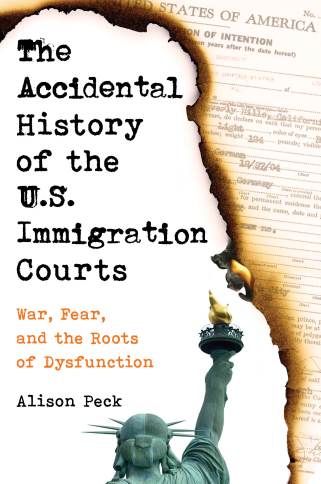
Trump speaks during an event to mark the 75th anniversary of D-Day.Matt Dunham/AP
During the Trump administration, Alison Peck started to see more of her cases have an outcome she describes as “a door just slammed” in the clients’ faces. A law professor and co-director of the Immigration Law Clinic at West Virginia University College of Law, Peck grew concerned that paths to immigration relief previously available were no longer an option. The explanation for it was an increasingly common practice whereby the US attorney general, who is a political appointee, would self-refer cases decided by an immigration judge and then use them as vehicles for broad policy changes. These precedent-setting determinations included restricting asylum for victims of domestic violence and gang violence, and limiting immigration judges’ power to manage their dockets by temporarily closing low-priority cases. Some of Peck’s clients were affected by both decisions. “It was very distressing to see this happen and have to tell people midway through the game that the rules had been changed,” she says. Hence, the experience of the door slammed shut.
Peck couldn’t wrap her mind around the fact that these high-stakes cases with potentially life-or-death consequences were not decided by impartial jurists in an independent court, but within the Department of Justice, a law enforcement agency. “It didn’t make sense to me, and it didn’t fit with anything I knew about administrative law theory,” she says. So Peck decided to look for an explanation for how this anomalous system had been set up in the first place, and what rationale, if any, sustained it despite a general consensus that the existing structure is nothing if not broken.
Peck shares her findings in the upcoming book The Accidental History of the US Immigration Courts: War, Fear, and the Roots of Dysfunction, a revealing account of how wartime paranoia and xenophobia shaped a system that has been with us for more than 80 years. “As long as the immigration courts remain under the authority of the Attorney General, the administration of immigration justice will remain a game of political football—with people’s lives on the line,” Peck writes. I called Peck to discuss what World War II and Nazi Germany have to do with present-day US immigration courts and how Congress can fix an “irrationally constructed” system. Our conversation has been edited and condensed.
You trace the origins of the architecture of immigration courts back to two pivotal moments. The first is 1940, when President Franklin D. Roosevelt moved the immigration services from the Department of Labor into the Department of Justice. How did that come about?
Immigration services had long been treated as kind of a stepchild within the Department of Labor. With the New Deal and the labor strife throughout the ’20s and into the 1930s, the secretary of labor had the obligation to deal fairly and impartially with union leaders, many of whom were immigrants, but then also had the responsibility of investigating and deporting immigrants who were in the country unlawfully. That tension started to become pretty extreme. Francis Perkins, the secretary of labor at the time, ended up being in the political crosshairs in part because of her handling of immigration cases. She was in favor of immigration being moved out of the Department of Labor, but she didn’t think it was very appropriate to have it in the Department of Justice because it shouldn’t be associated with crime and law enforcement.

In fact, Roosevelt had resisted members of Congress and the public for over a year. He had lawyers in the DOJ study the issue, and they sent him a report concluding that moving the immigration services into the DOJ would be inappropriate and could change the understanding of immigration for the country. His attorney general at the time, Robert H. Jackson—who later became a Supreme Court justice and also presided at the Nuremberg trials—advised him against it, calling for a sort of temporary wartime agency that dealt with the threat of sabotage, rather than setting up a system that invites an entry of politics into immigration cases. So it’s not as if Roosevelt and his advisers didn’t understand the risks of what they were doing. They did, and they resisted it for some time. But because of the fear and the nature of the threat and things that they just couldn’t have known at the time, they decided, for lack of any better option, that they would do this.
At the time, the Roosevelt administration justified the move as a necessary response to a national security threat. How exactly did the war in Europe ultimately influence his decision?
In 1939, much of Congress was still pretty isolationist, and there was a lot of skepticism about Roosevelt’s willingness to get involved in the war and make the United States a leading force. The occupation of Denmark by the Nazis in April 1940 was really a game changer. The isolationism of the United States up until that point was based on this notion that we’re an ocean apart and protected by geography—what happens in Europe can’t affect us directly. But Denmark had possession of Greenland, so the Nazis had a base in North America where they could refuel, restock, and plan attacks from there.
By that time, the State Department and the FBI were both actively tracking what they saw as the “Fifth Column” threat: this idea that foreign nationals might be plotting to take over from within the country without anyone ever knowing what happened. When the invasion of France and the Low Countries occurred in May [1940], many people assumed that this must have been because people in high level positions within these countries were simply raising the drawbridge and letting the Nazis through without resistance. [Roosevelt] was very influenced by the visit that the Undersecretary of State Sumner Welles had paid to the Axis powers. He came back very worried and told Roosevelt “I think we need to make this move.” After Roosevelt had said no for a year, he changed his mind and within three days, it was done.
This decision looks very different in retrospect, doesn’t it?
It’s understandable in historical context that Roosevelt felt that he needed to do something to protect against what could be a serious threat. But in hindsight, he realized the fears were misplaced. As it happened, the Nazis kept their plans very close to the vest and didn’t trust people outside their inner circle. This “Fifth Column” was actually just propaganda and the enemy stoking fear in order to create insecurity and undermine Allies’ morale.
Looking back now, 80 years later, it certainly has had the effect that Roosevelt and his advisors feared of making immigration be equated with crime and caught up with the political process. It really is sort of a function of historical accidents that we have the system where it is. It’s not the case that anyone ever said it would make good sense from an administrative law perspective to have immigration adjudication done in the Department of Justice under the control of the attorney general. That was not a conversation that ever occurred. What happened was that people were understandably fearful at the time of national security crisis and were easily swayed by fear and propaganda that was spread precisely to create that type of fear.
You write that the scenario Roosevelt had feared 60 years earlier of a foreign attack from within the country came to be in the early 2000s with 9/11, and that in turn overhauled immigration policy in the 21st century. What did that overhaul mean specifically for immigration courts?
I looked to see whether there had ever been serious consideration of changing this system in the last 80 years, particularly after the realization that this so-called “Fifth Column” never really existed, and this was really just a response to Nazi propaganda that we are still stuck with. What I found was that in the 90s, there was some movement toward reform, but then 9/11 happened and changed the way Americans were thinking about foreign nationals, immigration, visas, and the relationship between the State Department and the FBI or other domestic law enforcement. For some time, it appeared that the immigration courts would be moved into [the recently created Department of] Homeland Security. Many people in Congress, especially Democrats, but some Republicans as well, were concerned about this. Maybe having it in a law enforcement agency wasn’t perfect, but having it in this national security agency, where it would once again be closely aligned with the prosecutors, would be even worse. With relatively little focus on the immigration courts at the time, the best that could be accomplished was to keep them in the Department of Justice instead of moving them into the Department of Homeland Security. It was an opportunity for reform that then got swept away by the events of 9/11.
After that, the issue sort of went underground again, until it started to appear on people’s radar screens during the Trump administration. Until then, the immigration courts were mostly allowed to function independently, and so people weren’t as up in arms about it. For the most part, Attorney Generals were pretty hands off and so people thought: Well, it’s a system that doesn’t make a whole lot of sense, but it mostly works, so it’s not that important to make this institutional change. I think it’s an unfortunate combination of political forces that has led the immigration courts to sort of limp along in this way.
Immigration courts were dysfunctional in nature long before Trump took office, but under his administration that gained a new dimension. What did this unprecedented politicization of the courts look like?
The Trump administration exposed the vulnerability that was already in the system. What we saw was a much higher level of intervention, about four times higher than even the George W. Bush administration, which had been the most active prior. One of the ways that happened was through the frequency with which the Trump administration used the attorney general’s self-referral power, which means the attorney general can take a case away from an immigration judge at any time and decide it as he wishes. In the Trump administration, that power was used 17 times in four years. Previously, the highest number had been 10 times over 8 years.
In one case, the attorney general made a statement that victims of domestic violence and gang violence would generally not meet the asylum standard. Officers within the Department of Homeland Security were confused by the scope of the decisions that were unprecedented. That confusion is still ongoing, and it affects what happens every day in the immigration courts. Immigration judges are feeling that their independence has been highly compromised, and they are hamstrung by the decisions of the attorney general to do things that they actually think are just. This system that everyone tolerated for a while, assuming and hoping there wouldn’t be abuses, has now shown to be very clearly subject to abuses.
There’s currently a backlog of more than 1.3 million cases. Yet despite what seems to be a consensus that immigration courts are not working as they should, we still have the same system from 80 years ago. Are there any solid arguments to justify keeping the immigration courts under the DOJ?
There may be an assumption by people that it was set up this way for a reason, and that we might be losing something if we changed it. When we look at the history, it makes clear that it really was a historical accident that we ended up with this system. There never was a coherent rationale. It was something that was done as a matter of exigency, when there wasn’t a good solution. And so they took a bad solution instead and stuck with it. There’s not a whole lot of efficiency or institutional knowledge that’s being gained by having these immigration courts within the Department of Justice.
I think most people in the United States are not even aware that the immigrant courts are not part of our federal judiciary. They may be assuming that there’s a certain fairness built in that we expect from the federal courts when, in fact, it isn’t there. These are not courts; they are part of a law enforcement agency. The system is actually set up in such a way that it allows for political decision-making to become part of these court cases in a way that Americans don’t usually think of court cases being decided. That’s really inconsistent with American notions of justice, fairness, and due process. We think that those are decided by what we hope and aspire to be independent judges who are not part of the political branches and not subject to the whims of politics. From that fundamental misunderstanding, if we look deeper, we can see a desire for change. We have the choice to change that now.
Your book seems to suggest that the problem runs way deeper than what stopgap measures like hiring more immigration judges could accomplish. What do you think is an appropriate approach to creating independent immigration courts?
Adding more immigration judges or changing the way immigration judges are hired to have more diversity are not bad ideas in and of themselves, but they don’t get at the root of the problem. The root of the problem is that the immigration courts were never really intended to be impartial courts. Under our basic founding constitutional principles of due process and separation of powers, we can and should protect the adjudication process and make it separate from the law enforcement process. The Biden administration could play a role by urging Congress to seriously consider and to pass legislation that would separate immigration courts into an Article I court system. Article I courts are a relatively independent system set up by Congress and, by definition, would create separation between the immigration courts and the executive branch. That would give us something that approaches the fairness that people deserve.













